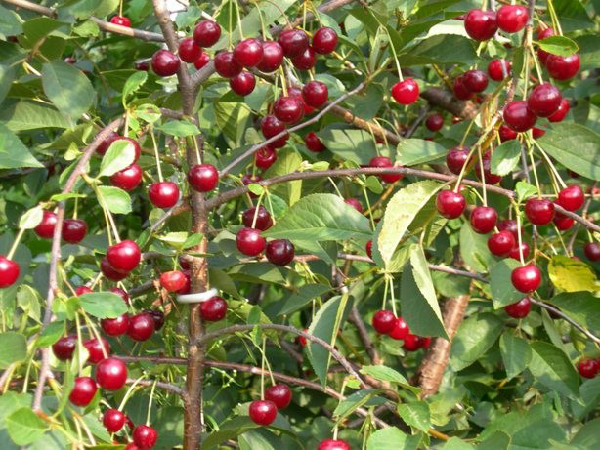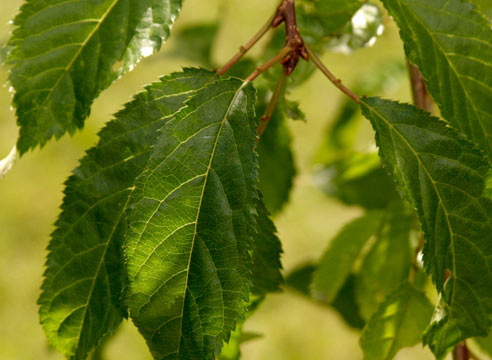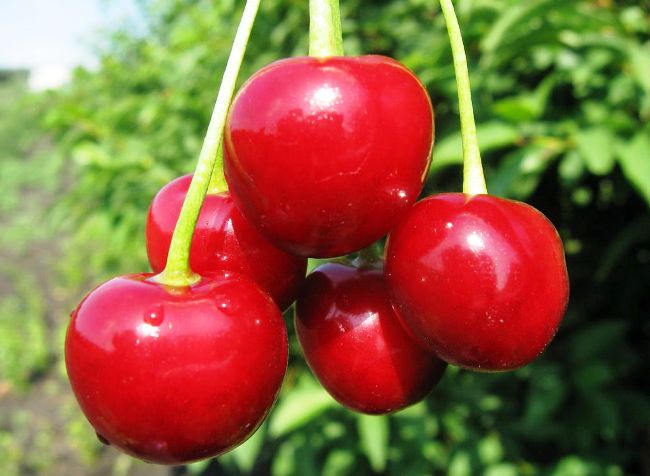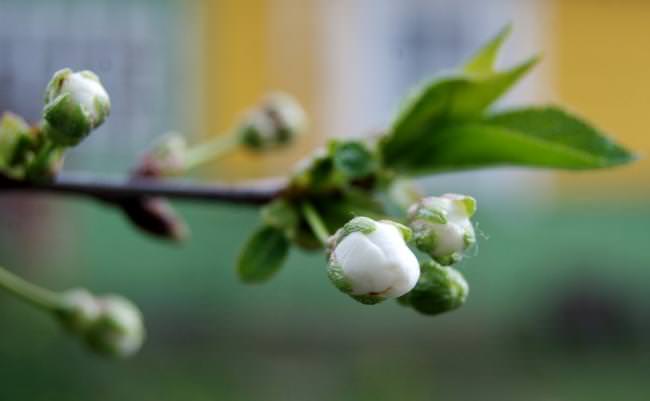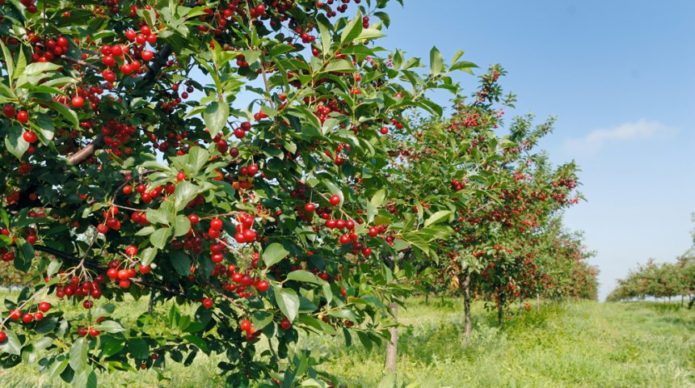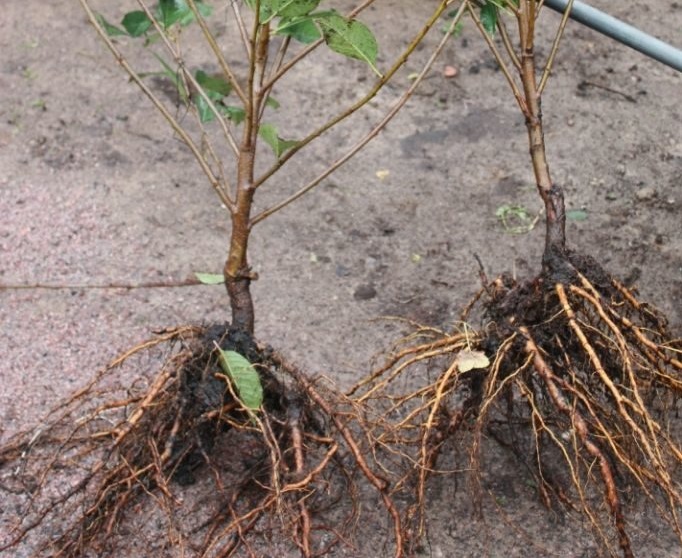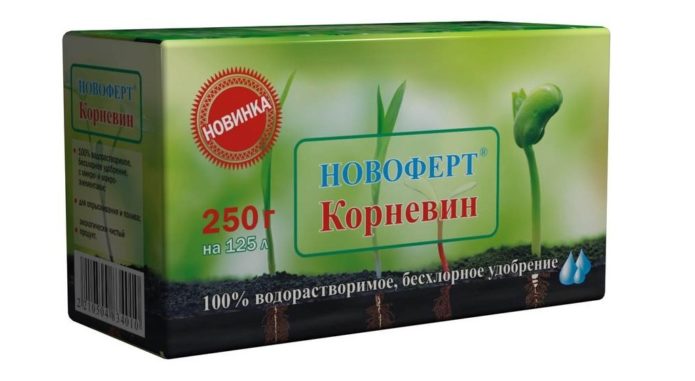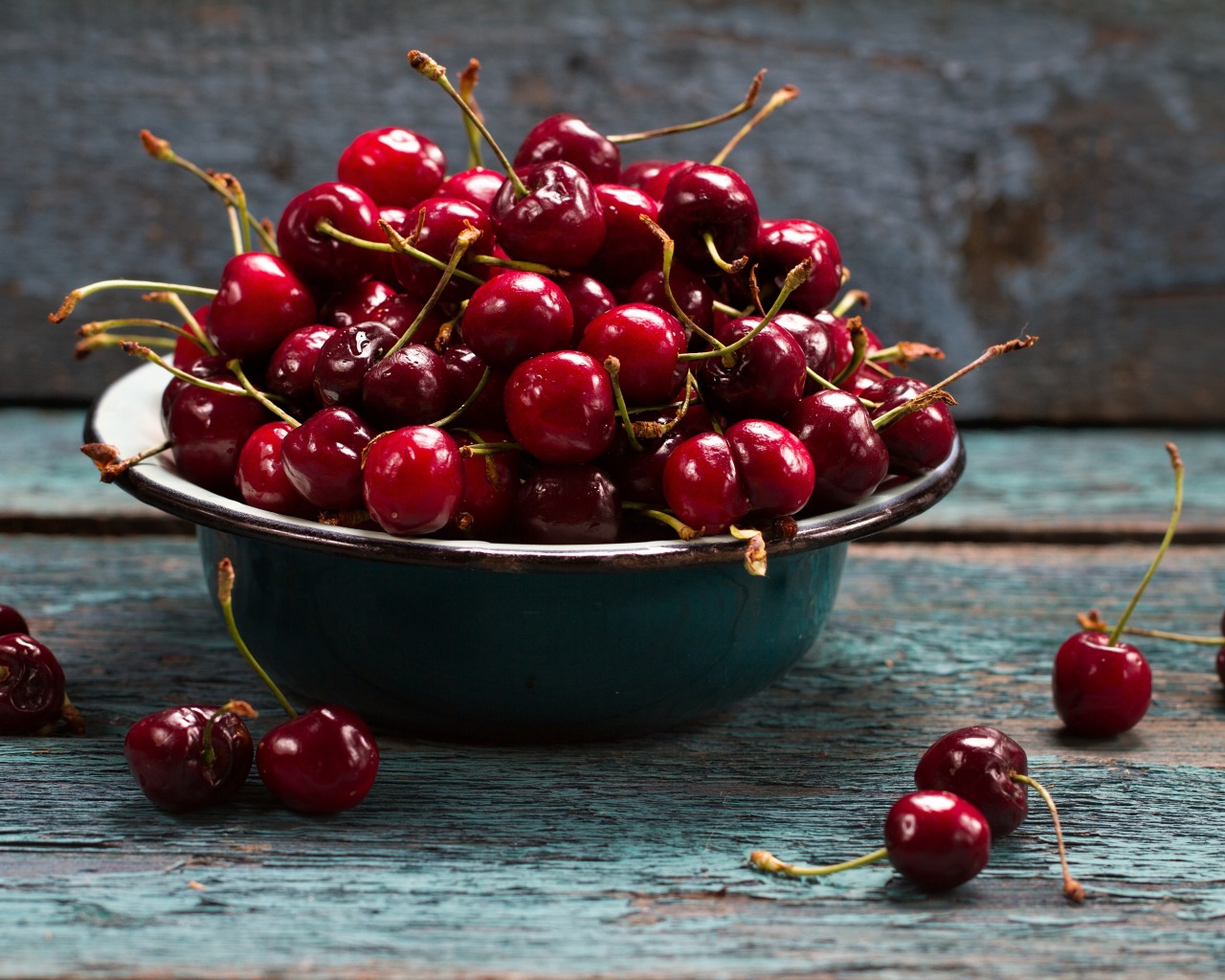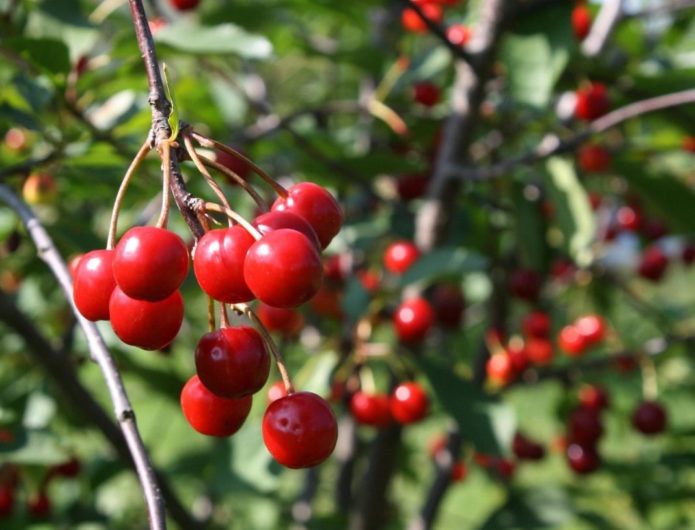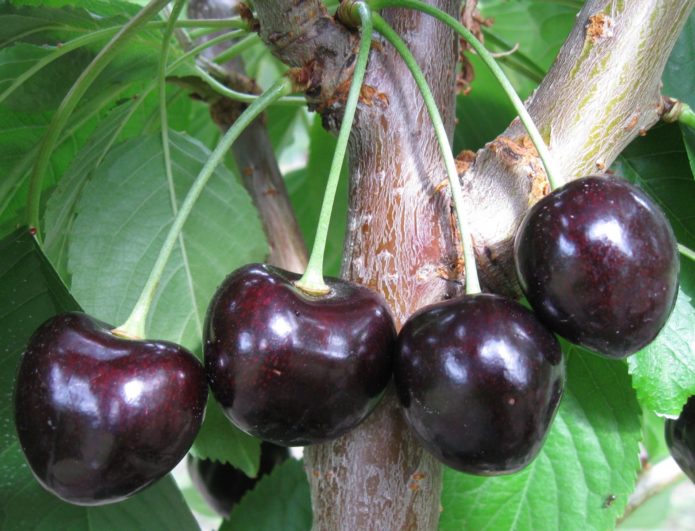Cherry has been cultivated by man since time immemorial. According to historians, this tree was cultivated as early as the 5th century BC - the aromatic cherry fruits were used to make syrup. For several centuries, mankind has accumulated rich experience in plant breeding and achieved the appearance of varieties that delight with stable yields and useful properties. One example is Lyubskaya cherry.
Content
Cherry Lyubskaya: history of origin
The variety is the result of the so-called folk selection - it appeared on the territory of Russia a very long time ago, but there is no reliable information about the place of origin of the cherry and the year of its breeding. There is no definite authorship either. The first scientific description of the variety appeared in the mid-30s of the last century thanks to the Russian naturalist N.I. Kichunov. He pointed out that Lyubskaya cherry has long been cultivated by residents of the Kursk province.
In 1947, Lyubskaya was sent for state variety testing. Soon the variety was included in the State Register and zoned for the North-West, Central, Central Black Earth, North Caucasian, Middle Volga and Lower Volga regions. The All-Russian Institute of Selection and Technology of Horticulture and Nursery was officially declared the originator.
Description of the variety
Outwardly, Lyubskaya looks like an ordinary bush cherry. The tree is weak, rarely grows above 2.5 m. The crown is sparse, spreading, rounded, often drooping, resembles a ball in appearance. The bark is grayish-brown, with clearly visible cracks, the young branches are brown in color with a slight silvery bloom.
Cherry Lyubskaya is prone to the formation of spontaneous somatic mutants - daughter plants that differ from the mother tree both in appearance and in characteristics. As a result of such mutations, the varieties Lyubskaya late, Lyubskaya bukhnaya and Lyubskaya yielding appeared.
Since the variety is bushy, fruits form on annual branches that deviate from the trunk by about 45 °. The buds are rounded, with small cones at the tips. The leaves are dull, dense, dark green in color, with yellowish-brown veins, jagged edges and pointed tops. An adult leaf has an oval shape and reaches a size of 8.7x5 cm.
Cherry inflorescences consist of 3-4 small white flowers with rounded, slightly corrugated petals. The diameter of each inflorescence is 3-4 cm. Depending on climatic conditions, flowering lasts 7-9 days, after which fruits begin to form on the branches. Cherries of this variety are collected in bunches of 2-4 pieces (although there are also single ones), placed on long thin petioles and weigh about 4-5 g.
In everyday life, cherry is usually called a berry, although from the point of view of biology, it is a stone fruit (drupe).
The tops of the fruits are flat, the funnels are of medium depth and width, the abdominal suture is light, well distinguishable.The peel of ripe cherries is dark red, firm and shiny, with many subcutaneous spots. The pulp is tender and juicy, it comes in light and dark red colors. The stone is oval, small.
The taste of Lyubskaya, perhaps, can be considered its disadvantage, since the taste of the fruits is sour and very mediocre. Therefore, it is better to prepare desserts, jams, compotes or homemade wine from this cherry. You can also freeze berries. The fruits are distinguished by good keeping quality and easily tolerate transportation.
Main characteristics
Although the variety is positioned as cold-resistant, Lyubskaya cherry is much more suitable for central and southern Russia than for the harsh climatic conditions of the north. The variety belongs to the middle-late: in the southern regions, fruit ripening occurs in mid-July, and in the northern regions - in late July-early August. The tree begins to bear fruit at the age of 2-3 years, and comes into full force in the 8-10th year. The yield is consistently high - if an adult plant is provided with proper care, it can produce more than 35 kg of berries in one season (the maximum yield is 54 kg per tree). At the same time, the tree bears fruit annually - unlike many other varieties, Lyubskaya is not afraid of cold and rainy spring and is not prone to freezing of flower buds.
A distinctive feature of the variety is its increased self-fertility, which means that the cherry does not need third-party pollinators to set fruit. This is a huge plus, allowing you not to worry that the weather, which is “non-flying” for the bees, will reduce the yield. And late flowering is a guarantee that return frosts in spring will not destroy the ovary. Ripe fruits of Lyubskaya cherry remain on the branches for a long time, without crumbling from them, and the compact size of the plant allows you to harvest and take care of the crown directly from the ground, without stairs.
Unfortunately, the described variety has rather significant drawbacks. Lyubskaya cannot be called durable - the tree is too much depleted, wasting energy on impressive harvests, so it lives no more than 15–17 years (while full fruiting will last 5–7 years). Despite the fact that the variety is considered frost-resistant, the wood of the trees freezes quite a bit, and in the summer heat, the bark on the trunk and branches suffers from sunburn. In addition, cherries are prone to coccomycosis and moniliosis.
Many gardeners claim that cherries, next to which celandine grows, are not damaged by coccomycosis.
Lyubskaya is very demanding on the composition of the soil - the tree will not grow and bear fruit on an infertile soil poor in useful microelements. For normal development and abundant fruiting, the plant should be provided with regular watering and enhanced nutrition.
Among the main advantages of the variety, it should be noted:
- high and stable yield;
- compact size of the tree, which makes it easier to care for and collect fruits;
- resistance of flower buds to freezing;
- increased self-fertility.
Among the disadvantages are:
- the tendency of wood to sunburn in summer and severe freezing in winter;
- frequent fungal infection;
- the peculiar taste of the fruit;
- the fragility of the tree.
How to plant cherries
Light neutral sandy loam, sandy soils and loams are suitable for cherry. These trees should not be grown on acidic peatlands and where groundwater comes very close to the surface of the earth. For planting, you need to choose areas with good lighting, protected from gusts of cold winds - such conditions contribute to high yields and accelerate the ripening of fruits.
In the central and southern regions, planting is recommended in October, but in the middle lane, it is better to plant trees in the spring, as soon as the last snow melts, because during autumn planting, a young plant may not survive severe frosts.
Before proceeding with planting activities, you should prepare the soil on the site. For example, in the middle lane, podzolic soils are often found - before planting cherries, they must be dug up with additional fertilizing. Calculation of fertilizers per 1 m2 would be like this:
- manure - 10 kg;
- mineral fertilizer - 200 g;
- potassium - 100 g.
You can also apply ready-made complex fertilizers - in this case, you should take about 150 g of top dressing per 1 m2 soil.
If the soil in the area where you plan to plant cherries is acidic, it must be limed. The dose of lime varies depending on the soil - for example, on heavy loams, add 700 g of lime per 1 m2, and on sandy loam soils, 500 g will be enough. Please note that lime cannot be added to the soil at the same time as organic matter.
For planting, you need to choose 1-year-old (up to 80 cm high) or 2-year-old (about 110 cm) trees - older cherries are difficult to take root in a new place. The roots of the seedling should be strong, developed, well-formed, the trunk should be smooth, evenly colored, without signs of damage.
After purchase, the roots of the plant are wrapped with a damp cloth so that they do not dry out during transportation. If this does happen, the root system needs to be placed in water for 6–8 hours to saturate it with moisture.
It is very useful to add Kornevin to the water - it will contribute to the early rooting, at first it will protect the plant from fungal attack. The dosage of the drug is indicated on the package.
Step by step planting process:
- A month (at least 2 weeks) before planting, a hole is dug at the site 40-60 cm deep and 50-60 cm in diameter and a fertile mixture is prepared: the top layer of the removed soil is mixed with humus, ash, potassium sulfate and superphosphate are added. Keep in mind that it is impossible to introduce lime and fertilizers that contain nitrogen into the planting pits - they will cause irreparable damage to the delicate root system of the cherry.
- Immediately before planting, a peg is installed in the center of the hole, which will serve as a support for the plant until it is completely rooted. A layer of fertile mixture is poured around the support and a seedling is placed on top, carefully straightening the roots. Make sure that the root collar of the cherry is 3 cm above the soil level.
- Sprinkle soil over the roots, slapping the soil lightly. When the hole is completely filled up, carefully compact the soil near the roots and within a radius of 30-40 cm from the tree trunk. Form an earthen roller around so that water does not flow out of the hole during watering.
- Cut the cherry so that no more than 0.5 m of the trunk remains above the root - this procedure will provoke the growth of the tree not upward, but in width, which will greatly facilitate the formation of the crown in the future.
- Tie a young tree to a support, pour 20-30 liters of standing water.
- Mulch the soil of the trunk circle with peat or humus.
The first 2-3 days after planting, the cherry is watered vigorously, while avoiding waterlogging.
Video: choosing a seedling and planting the right cherry
Care features
Caring for Lyubskaya cherries consists in observing certain agrotechnical rules:
- In early spring, the soil of the trunk circle should be mulched with a 5 cm layer of compost or sawdust.
- Lyubskaya cherry should provide good moisture during the formation of shoots, flowering and ripening of fruits. For one watering, each tree should receive at least 30 liters of water. Additional moisture is required in dry and hot weather. It is better to use rainwater or settled water for irrigation.In the last decade of September, water-charging irrigation is carried out, adding 60-80 liters under each cherry and ensuring that the soil is soaked 0.5 m deep.
- Although cherries of this variety have increased self-fertility, gardeners recommend sprinkling trees with a honey solution (100 g of honey per 10 liters of water) during flowering to attract pollinating insects.
- Since Lyubskaya is very demanding on the composition of the soil, throughout the life of the tree it is necessary to provide it with good nutrition - in particular, mineral fertilizing at the beginning of the growing season. Cherries begin to fertilize from the third year of life, that is, from the moment they enter fruiting. In the spring, the plant needs nitrogen (50–70 g per tree), in the fall - potassium (60–80 g) and phosphorus (150–200 g). As soon as the cherry blossoms, you need to water it with a nutrient solution (dilute 25 g of superphosphate in 10 liters of water, 15 g of potassium chloride and urea each). After 10 days, feeding is repeated. Once every two years, trees are fertilized with organic matter - compost or rotted manure.
- During the summer, loosening the soil should be carried out 2-3 times in the tree trunk circle. In spring and autumn, the soil near the plant is dug up, thus improving aeration.
- Be sure to pull out weeds near the trunk so that they do not pull useful elements from the ground and do not provoke the development of fungi.
- Since the Lyubskaya variety is susceptible to fungal diseases, it is necessary to regularly carry out preventive spraying with fungicidal preparations (Skor, Profit, etc.). Treatments are carried out three times per season: before bud break, before flowering and 2-3 weeks after it. To prevent the appearance of pests, at the beginning of spring, the tree is treated with an aqueous solution of urea (the ready-made solution can be purchased at garden stores). Spraying with preparations containing copper is very effective. Noticing clear signs of disease or pest infestation, they are treated with appropriate insecticidal or fungicidal preparations, following the manufacturer's instructions.
- The crown of Lyubskaya cherry is usually rare, there are no special problems with its formation - you just need to remove dry and diseased branches, root shoots in time. Pruning is carried out in the spring, before bud break. Wounds on the bark of a tree with a depth of more than 1 cm must be treated with a 1% solution of copper sulfate, and then covered with garden varnish.
- If the soil on the site has an acidic reaction, add dolomite flour, wood ash or lime at least once every 5–6 years. Such a procedure not only helps to reduce acidity, but also strengthens the roots of plants, helping them to better absorb nutrients from the soil.
- So that the cherry does not suffer from severe frosts, for the winter the lower branches and the bottom of the trunk are tied with spruce branches, and the top is covered with agrofibre.
Video: cherry pest control
Variety reviews
We planted Vladimirka, Shubinka, Lyubskaya. Everything was useless, the color was always beaten by frosts, there were berries - one or two and too many. And in the end, everything froze in cold winters. Dacha 60 km along the Yaroslavl sh.
Last summer I bought a cherry sapling with a closed root, variety Lyubskaya. I planted it, in the spring I did not like his place of residence, I crossed it with a lump of earth to a new place. My cherry blossomed like a crazy one, there was no foliage to be seen, the harvest also pleased me. This year the picture is the same. The tree is a little more than a meter high, but it seems that the harvest will please this year as well. I was a little upset by the size of the berries last year, let's see what happens this year.
Lyubskaya is an old variety from the times of our great-great-grandmothers. Stunted (up to 2.5 m). Sour, tasteless berry. It will work very well for compote, but you are unlikely to eat it raw. However, this variety is still valuable and can be recommended to a friend. It is self-fertile, fruitful, and is a pollinator for many varieties of cherries. And for Zhukovskaya and Turgenevskaya, by the way, too.The berries ripen late (end of July, August) and hang ripe for a long time without sprinkling. Fast-growing, at 2 years old it can begin to bear fruit. Winter hardiness is low, it is not resistant to diseases. It will not take up much space, but it pollinates good cherries and the harvest itself will give for winter compotes.
There is a lot of trouble with cherries of the Lyubskaya variety, and this point should be taken into account by novice gardeners. However, having received appropriate care, the tree will thank its owner with stable and high yields.
